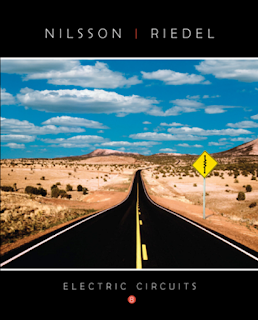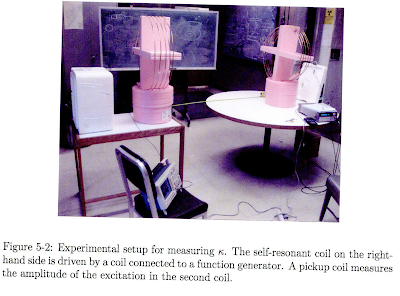Power Transfer Through Strongly Coupled
Resonances
by
André Kurs
Submitted to the Department of Physics
in partial fulfillment of the requirements for the degree of
Master of Science in Physics
at the
MASSACHUSETTS INSTITUTE OF TECHNOLOGY
September 2007.
Chapter 1
Introduction
At the turn of the 20th century, Nikola Tesla [1, 2, 3] devoted much effort to developing
a system for transferring large amounts of power over continental distances. His main
goal was to bypass the electrical-wire grid, but for a number of technical and financial
difficulties, this project was never completed. Moreover, typical embodiments
of Tesla's power transfer scheme (e.g., Tesla coils) involve extremely large electric
fields and are potential safety hazards. The past decade has witnessed a dramatic
surge in the use of autonomous electronic devices (laptops, cell-phones, robots, PDAs,
etc) whose batteries need to be constantly recharged. As a consequence, interest in
wirelessly recharging or powering such devices has reemerged [4, 5, 6]. Our attempts
to help to fulfill this need led us to look for physical phenomena that would enable
a source and a device to exchange energy efficiently over mid-range distances, while
dissipating relatively little energy in extraneous objects. By mid-range, we mean that
the separation between the two objects effecting the transfer should be of the order
of a few times the characteristic sizes of the objects. Thus, for example, one source
could be used to power or recharge all portable devices within an average-sized room.
A natural candidate for wirelessly transferring powering over mid-range or longer
distances would be to use electromagnetic radiation. But radiative transfer [7], while
perfectly suitable for transferring information, poses a number of difficulties for power
transfer applications: the efficiency of power transfer is very low if the radiation is
omnidirectional (since the power captured is proportional to the cross-section of the
receiving antenna, and most of the power is radiated in other directions), and requires
an uninterrupted line of sight and sophisticated tracking mechanisms if radiation is
unidirectional (which might also damage anything that interrupts the line of sight).
An alternative approach, which we pursue here, is to exploit some near-field interaction
between the source and the device, and somehow tune this system so that
efficient power transfer is possible. A recent theoretical paper [8] presented a detailed
analysis of the feasibility of using resonant objects coupled through their near-fields
to achieve mid-range energy transfer. The basic idea is that in systems of coupled
resonances (e.g. acoustic, electro-magnetic, magnetic, nuclear), there may be a general
strongly coupled regime of operation [9]. It is a general physical property that
if one can operate in this regime in a given system, the energy transfer is expected
to be very efficient. Mid-range power transfer implemented this way can be nearly
omnidirectional and efficient, irrespective of the geometry of the surrounding space,
and with low losses into most off-resonant environmental objects [8].
The above considerations apply irrespective of the physical nature of the resonances.
In the current work, we focus on one particular physical embodiment:
magnetic resonances [10], meaning that the interaction between the objects occurs
predominantly through the magnetic fields they generate. Magnetic resonances are
particularly suitable for everyday use because biological tissue and most common
materials do not interact strongly with magnetic fields, which helps make the system
safer and more efficient. We were able to identify the strongly coupled regime
in the system of two coupled magnetic resonances by exploring non-radiative (nearfield)
magnetic resonant induction at MHz frequencies. At first glance, such power
transfer is reminiscent of the usual magnetic induction [11]; however, note that the
usual non-resonant induction is very inefficient unless the two coils share a core with
high magnetic permeability or are very close to each other. Moreover, operating on
resonance is necessary but not sufficient to achieve good efficiency at mid-range distances.
Indeed, Tesla's pioneering work made extensive use of resonant induction,
and many technologies available today (e.g., radio receivers, RFID tags, and cochlear
implants [12]) also rely on resonance, yet their efficiencies are not very good at mid
range distances. Operation in the strong-coupling regime, for which resonance is a
precondition, is what makes the power transfer efficient.
LINK THESIS
http://www.mediafire.com/download/ctld702cydgxh4c/317879200-MIT.pdf
















































 JOSIL ARTISTA PLASTICO FORTALEZA CEARA BRASIL AV.HERACLITO GRAÇA 41 TEL(85)32542378
JOSIL ARTISTA PLASTICO FORTALEZA CEARA BRASIL AV.HERACLITO GRAÇA 41 TEL(85)32542378
















